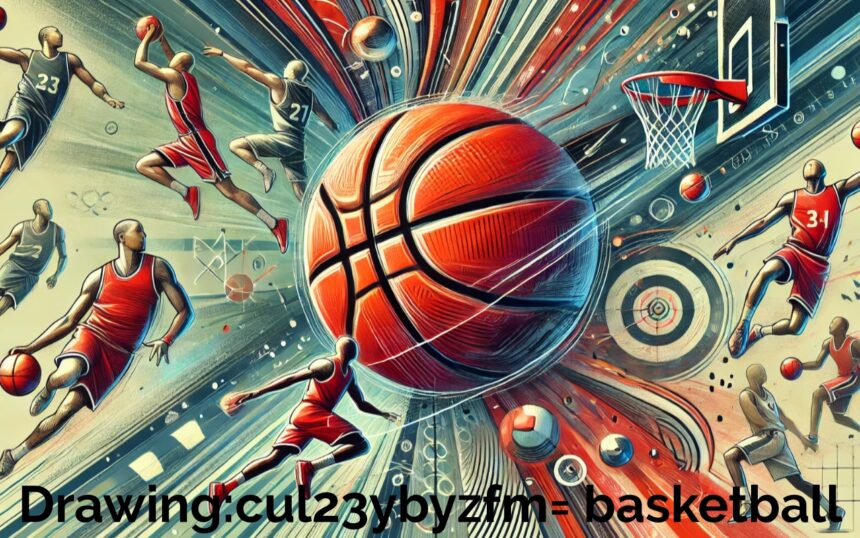Basketball is more than just a sport; it’s an art form. From the fluid movements of athletes on the court to the intricate designs on the ball, basketball offers endless inspiration for artists. Whether you’re an experienced artist or just starting out, this article is designed to provide you with creative drawing:cul23ybyzfm= basketball ideas that will spark your imagination. We’ll explore different techniques, styles, and concepts that can help you bring the excitement and energy of basketball to life on paper. So, grab your pencils and sketchpads, and let’s get started!
Understanding the Fundamentals of drawing:cul23ybyzfm= basketball
Before diving into creative drawing ideas, it’s essential to understand the basics of drawing a basketball. The most recognizable feature of a basketball is its circular shape and distinctive line patterns, which give the ball its character. Achieving accurate proportions and symmetry is key to making your drawing look realistic.
To begin, sketch a perfect circle, as this forms the foundation of your basketball drawing. Then, draw the classic curved lines that span across the ball’s surface. These lines intersect and divide the ball into symmetrical sections, representing the seams that define the ball’s structure. Mastering this simple yet fundamental step will set you up for more complex and artistic interpretations of basketball drawings later on.
Once you’re comfortable with the basic structure, try experimenting with shading techniques. Adding shadows and highlights can give your drawing a three-dimensional feel, bringing the basketball to life on the page. This is particularly important for artists who want to depict motion or realism in their basketball-themed artworks.
Exploring Different Artistic Styles for drawing:cul23ybyzfm= basketball
Art comes in many styles, and basketball-themed drawings are no exception. Whether you prefer realism, abstract, or cartoon styles, incorporating different artistic techniques can enhance the uniqueness of your work. Let’s break down some of these styles and how they can be applied to drawing:cul23ybyzfm= basketball:
Realism
Realism focuses on making the basketball look as lifelike as possible. This style requires a deep understanding of light, shadow, and perspective. Pay close attention to the small details, such as the texture of the ball’s surface, which often has small dimples for grip. Adding subtle details like these makes your drawing more authentic and visually striking.
Abstract
For a more avant-garde approach, try drawing basketball in an abstract style. Here, the focus is not on realism but on using shapes, colors, and patterns to convey the essence of basketball. You can distort the form of the ball, exaggerate its features, or play with bold, non-representational colors to evoke emotions or movement. Abstract drawings allow for more creative freedom and personal expression, making them ideal for artists who want to push boundaries.
Cartoon
Cartoon drawings are a fun way to capture the playful side of basketball. In this style, you can exaggerate features, simplify shapes, and use vibrant colors to give your drawing a light-hearted, whimsical feel. Cartoon basketball drawings are popular in illustrations for children’s books, comic strips, or animations. This style is perfect for those who enjoy creating exaggerated, humorous, or highly stylized representations of the sport.
Incorporating Movement and Action in Basketball Drawings
Basketball is a sport defined by motion—players sprint across the court, leap into the air for a dunk, or dive to make a steal. Capturing that sense of movement in your drawing adds energy and excitement to your artwork.
Freeze-Frame Action Shots
One way to depict movement is by drawing freeze-frame action shots. Imagine a player mid-air, just before making contact with the ball for a slam dunk. Focus on the pose, muscle tension, and angle of the limbs to create a dynamic image. The basketball itself can be shown in motion, using techniques like motion lines or blurring to indicate speed.
Sequential Sketches
Another way to capture movement is through sequential sketching, which involves drawing multiple frames that illustrate a player’s motion over time. Think of this technique as similar to storyboarding or creating a comic strip. Each sketch captures a different moment in the sequence of actions, giving the viewer a sense of the progression of movement.
Conveying Energy with Backgrounds
Backgrounds also play a significant role in conveying action. Try using diagonal lines, splashes of color, or abstract shapes in the background to suggest speed and movement. You don’t have to go overboard; subtle hints in the background can enhance the overall impact of the main subject and give the artwork a sense of motion and urgency.
Adding Depth and Perspective in drawing:cul23ybyzfm= basketball
Creating depth and perspective is another critical element in basketball drawings. Perspective can make your drawing more dynamic, allowing you to emphasize the size and proximity of the basketball or player in relation to the viewer.
One-Point Perspective
Using a one-point perspective allows you to create a sense of depth in your drawing. For instance, if you’re drawing a basketball hoop, you can make it appear as if the viewer is looking up at it from below. The ball could be depicted mid-air, about to drop into the hoop. This technique requires understanding of vanishing points and how lines converge in a single spot on the horizon, creating an illusion of depth.
Foreshortening
Foreshortening is another valuable technique for depicting basketball drawings. This involves drawing the object or figure in a way that conveys depth or distance. For example, if you’re drawing a player extending their arm toward the viewer, the arm might appear larger in the foreground, while the rest of the body seems to recede into the background. This technique makes your drawing more engaging and creates a sense of immersion for the viewer.
Shadows and Lighting
Strategic use of shadows and lighting can also add depth to your drawing. Shadows on the ground beneath the basketball or player give the impression of a three-dimensional space, while light sources can create dramatic effects by casting highlights on certain parts of the ball or player. Experimenting with different lighting angles can result in a more engaging and professional-looking piece of art.
Exploring Color Schemes in Basketball Drawings
Color adds an emotional dimension to any artwork, and basketball drawings are no exception. Whether you choose to stick with the traditional orange and black of a basketball or branch out into more imaginative color schemes, the use of color can enhance the mood and impact of your drawing.
Traditional Colors
In realistic drawings, sticking with traditional colors can make your art more recognizable and relatable. The orange surface of the basketball, the white or black seams, and the vibrant colors of players’ jerseys all play a role in making your drawing feel authentic.
Experimental Colors
On the other hand, experimenting with non-traditional color schemes can make your drawing stand out. Consider using bold, contrasting colors to highlight certain elements of your drawing. For instance, you could use neon shades to give your basketball a futuristic look, or muted pastels to create a more subdued, dream-like atmosphere. Don’t be afraid to push the limits and explore color combinations that reflect your personal style.
Black and White Drawings
Black-and-white drawings, especially when done with ink or pencil, can also make a strong impact. Without color, the focus shifts to texture, line work, and shading. Black-and-white basketball drawings can evoke a sense of nostalgia or give your artwork a sleek, minimalist look. The contrast between light and dark can be used to emphasize certain areas of the drawing and guide the viewer’s attention to the most important details.
Themed Basketball Drawings for Special Occasions
Creating themed basketball drawings can be a fun way to add variety to your art. Whether it’s for a particular season, a special event, or a personal project, themed drawings allow you to explore new ideas and incorporate elements beyond just the sport itself.
Seasonal Themes
Consider drawing a basketball scene with a seasonal twist, such as a winter basketball game with snow falling in the background, or a beachside summer game with palm trees and waves crashing in the distance. These types of themed drawings offer a unique take on the sport and challenge you to blend different environmental elements with the core subject of basketball.
Celebratory Drawings
Special occasions, such as a championship win or a favorite player’s retirement, also provide inspiration for themed basketball drawings. You can create a commemorative piece that captures the momentous occasion. For example, you could draw a trophy surrounded by basketballs or a portrait of a player lifting the championship trophy in a victory pose.
Using Mixed Media for drawing:cul23ybyzfm= basketball
Don’t feel confined to just pencil and paper when creating your basketball drawings. Mixed media is a great way to add texture, depth, and interest to your work.
Combining Different Mediums
Try combining different art materials, such as pencil, ink, and watercolor. For instance, you can draw the basketball in pencil for detailed line work and use watercolor to fill in the background with soft, flowing colors. The combination of media adds richness to your artwork and allows you to experiment with different textures and visual effects.
Digital Art
If you prefer digital art, basketball drawings can also be brought to life through graphic design software. Digital drawing tools give you the ability to play with a wide range of colors, textures, and effects that might be difficult to achieve with traditional media. Programs like Adobe Illustrator or Procreate allow you to experiment with layers, create clean lines, and easily make adjustments as you work.
Read More: Explore Key Moments from Meet the Press S76E49: Expert Analysis Included
Final Thoughts on Creative drawing:cul23ybyzfm= basketball
Basketball offers endless inspiration for artists, from the simple geometry of the ball to the fast-paced action of the players. Whether you’re focusing on realism, abstraction, or themed artworks, the key to creating engaging drawing:cul23ybyzfm= basketball pieces lies in your willingness to experiment and push your creative boundaries. With the right techniques, and a solid understanding of the fundamentals, you can transform a simple basketball into a compelling piece of art that resonates with viewers.
As you continue to develop your basketball-themed drawings, remember that the most important aspect is your personal artistic vision. Don’t be afraid to try new things, even if they feel unconventional. Art is all about exploring your creativity, and there’s no one “right” way to depict basketball in your drawings. Whether you focus on capturing a realistic slam dunk or dive into abstract interpretations of the sport, the possibilities are endless.
Additionally, drawing basketballs and basketball players offers a great opportunity to improve your technical skills. From mastering anatomy in player drawings to honing your ability to create perspective and depth, basketball art challenges you to grow as an artist. The combination of precise structure and dynamic movement provides a rich subject matter for both seasoned professionals and aspiring artists alike.
In the end, whether you’re sketching a quick doodle or working on a complex, large-scale piece, basketball drawing allows you to blend sport and art in a way that’s both fun and fulfilling. So, embrace the challenge, enjoy the process, and keep pushing your creative limits. With dedication and practice, you’ll find that drawing:cul23ybyzfm= basketball can become a central theme in your artistic portfolio, or simply a delightful way to express your love for the game.



